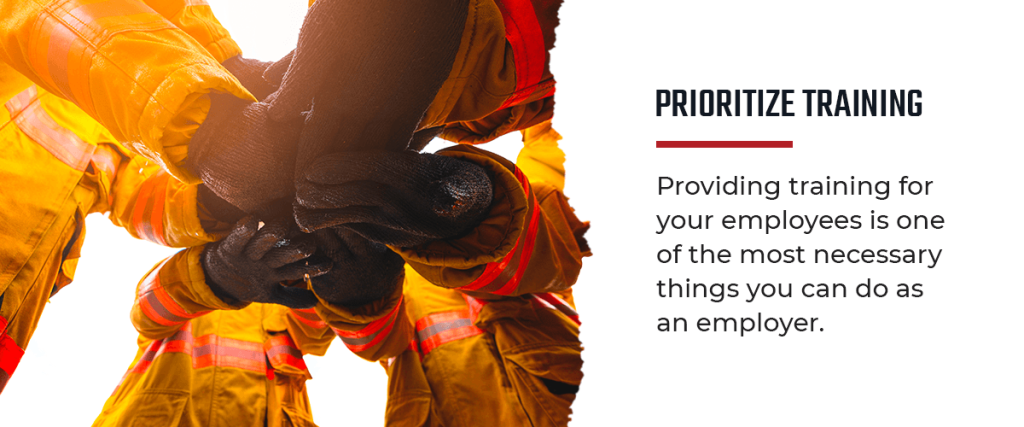OSHA – Now Requiring Reporting for Amputations

OSHA – Now Requiring Reporting for Amputations
An amputation is unimaginable, but it’s important to be prepared and know what to do if it should ever happen. The Occupational Safety and Health Administration (OSHA) has many safety standards and regulations to prevent these injuries from occurring, but in the event of an accident, they also provide ways to report these amputations.
While compliance, penalties, fines and reporting are one aspect of your business, your most important role is caring for your employees. Their health, safety and well-being should be the number one item on your list when it comes to leadership. In this article, we’ll discuss the OSHA regulations surrounding these accidents and how you can improve your workplace safety to better protect your workers.
Had an Amputation at Work? What Now?
It’s critical to know the proper procedure if there should be an amputation at your business. While some may not even want to consider this as a possibility, you owe it to your employees to remain educated in the OSHA guidelines. You are also obligated to report any amputations within 24 hours of the incident. Knowing the rules surrounding these incidents will help you protect everyone around you and report the amputation properly to avoid any other occurrences.
It’s important to note that OSHA may make revised rules for safety procedures, and the final rule will always be updated on their website, so it’s critical to check these policies periodically. Under new OSHA guidelines, an amputation is the traumatic loss of external body parts, including limbs. An amputation is considered the loss of a part, such as an appendage or limb, that has been partially or completely cut off or severed. However, an amputation does not always require the loss of bone. Some criteria that fall under amputations include:
– Body parts that have been reattached
– Loss or physical removal of an eye
– Medical amputations due to severe damage
– Fingertip amputations with or without bone loss
OSHA states that amputations do not include:
– Chipped or broken teeth
– Loss of sight without removal of the eye, unless resulting in work-related hospitalization
– Severed ears
– Scalpings
– Avulsions
– Deglovings
– Enucleations
While you may understand these guidelines, if an amputation were to occur, it’s understandable you may need to double-check with a health care professional to diagnose the injury as an amputation before reporting. It’s also common to confuse amputations with avulsions, which you do not need to report to OSHA. Avulsions include incidents like:
– Eyelid removal
– Fingernail or toenail removal
– Loss of a tooth
Once you have determined whether the case is an avulsion or amputation, it’s time to take action. If the injury falls under OSHA 1904 Subpart E section for amputation reporting guidelines, here are some rules you need to follow:
– You must report an employee’s amputation or loss of an eye due to a work-related incident within 24 hours.
– You must also report the in-patient hospitalization due to a work-related incident within 24 hours.
– You must report the amputation or loss of an eye by telephone, in person at their nearest office, or by electronic submission with the reporting application on their website.
– If your nearest OSHA office is closed, you must call the 800 number or use the online reporting application.
Once you determine how you will report the amputation, here’s the information you will need to provide:
– The name of your business or organization
– The location of the amputation
– The time the amputation occurred
– The type of event, such as in-patient hospitalization, loss of an eye or amputation
– The number of employees who suffered the amputation
– The name of the employee(s) who suffered the amputation
– Your contact information
– A description of the amputation or work-related incident
How to Care for Your Employees and Prevent Amputations
The most important thing to do when one of your employees suffers an amputation is to prioritize their health and well-being. Such a traumatic event can certainly be difficult for your other employees, but the person affected will likely be dealing with incredible stress and pain. The best thing you can do is create a workplace safety culture and educate your employees on why you have certain procedures and practices in place.
Here are some tips for creating a culture of safety in the workplace to keep these accidents from happening.
1. Prioritize Training
Providing training for your employees is one of the most necessary things you can do as an employer. Many different businesses work with tools, machines and chemicals that can be hazardous, dangerous or even fatal if mishandled. It’s crucial that your employees are adequately trained and aware of all the hazards around them to maintain workplace safety.
Once you go through the training sessions and educate your staff on the correct use of safety equipment, it’s a good idea to regularly review these points to reiterate their importance.
2. Lead by Example
As an employer or manager, it’s your job to set the standard for workplace culture regarding safety and compliance. Your employees may not think the safety procedures are important if they never see their superiors following them. In many businesses, there’s a lot of talk about safety but no action. When you follow all safety procedures and policies, you’ll encourage your employees to follow suit.
3. Communicate
Having open communication within your business can benefit you in many ways, such as making employees more comfortable voicing their concerns, asking questions and learning about safety risks. Building a positive work culture makes it easier to uphold these regular safety talks. Communicate your business’s expectations for safety by having your policies easily visible on paper, electronically or even posted around your office or job site.
4. Keep Your Workers Involved
Maintaining a strong safety culture takes responsibility on everyone’s end. Involving your employees in the process of building this positive culture around safety can make them see just how important it is to your business — and for the sake of their health and well-being. You can ask your employees for feedback on how to improve your current procedures and communication methods to help enhance your overall reporting process.
5. Develop a Thorough and Positive Reporting Process
Incentives are a great way to reward employees who carefully watch for and report safety hazards. When your employees believe that the reporting process is honest and positive, they’ll likely be more comfortable coming forward with a safety concern or having a conversation about where things can improve.
Mix Compliance With Care for Employees
While you must report amputations that fall under specific guidelines, it’s important to remember that your employees are your number one priority. When you show your employees how important compliance and safety are, you can also mention how it’s for their personal safety and keeping them protected on the job. Reporting and penalties are necessary, but caring for your employees and ensuring no harm comes to them is the first step to avoiding these incidents.
However, managing a business while upholding safety and a positive workplace culture can be challenging, so it’s a good idea to rely on professionals who can develop unique solutions to help you ensure compliance, avoid fines and prevent injuries from happening in the first place. With professional consultants, you can go beyond OSHA compliance and keep your employees focused and engaged without neglecting your preparedness for potential emergencies. Having actionable strategies in place will make everyone feel more at ease and ready to handle any situation.
How 2Six Advisors Can Help Your Business
While you’re required to report an amputation, it shouldn’t happen in the first place. It’s critical to uphold proper safety procedures and ensure your employees are safe, particularly if they’re working with heavy machinery or other dangerous materials on a daily basis. At 2Six Advisors, we provide occupational safety consulting to help create a culture of safety in your workplace and help you avoid serious injuries or amputations.
We focus on long-term, comprehensive and customized solutions that will lead to improved security and safety while decreasing your costs. Our team can identify and manage health and safety risks before they get out of hand and lead to accidents or costly fines. Contact us today to see how we can help your business.



